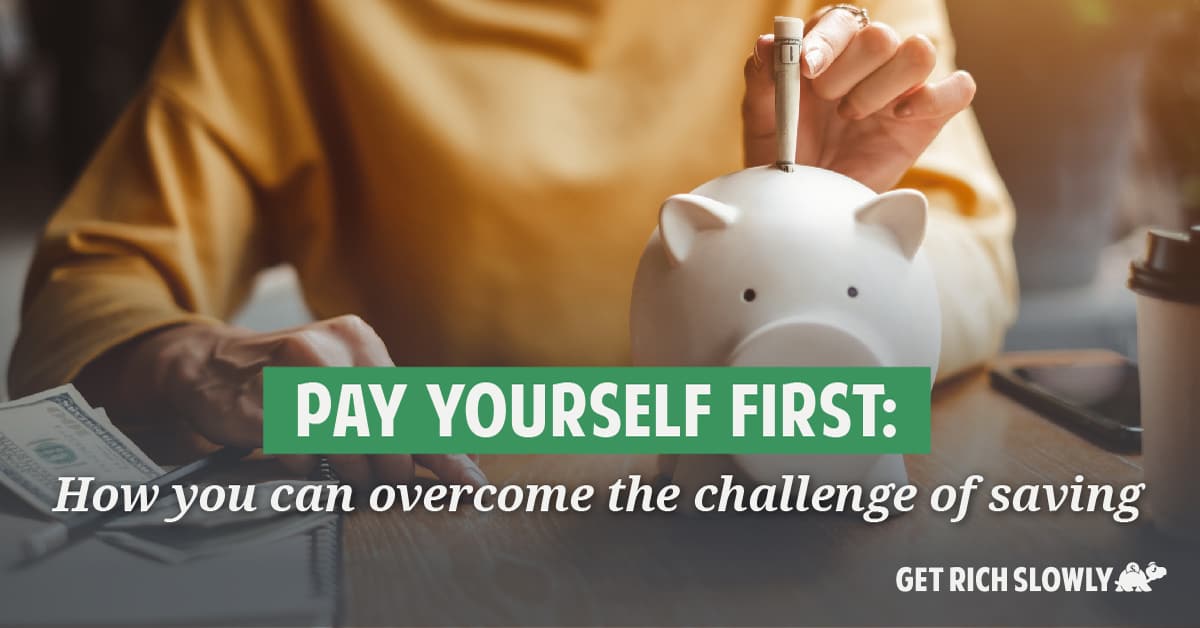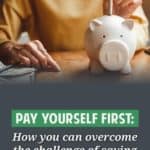Pay yourself first: How you can overcome the challenge of saving

One of the oldest rules of personal finance is the simple admonition to pay yourself first. All the money books tell you to do it. All the personal finance blogs say it, too. Even your parents have given you the same advice.
But it’s hard. That money could be used someplace else. You could pay the phone bill, could pay down debt, could buy a new DVD player. You’ve tried once or twice in the past, but it’s so easy to forget. You don’t keep a budget, so when payday rolls around, the money just finds its way elsewhere.
And besides: What does “pay yourself first” even mean?
To pay yourself first means simply this: Before you pay your bills, before you buy groceries, before you do anything else, set aside a portion of your income to save. Put the money into your 401(k), your Roth IRA, or your savings account. The first bill you pay each month should be to yourself. This habit, developed early, can help you build tremendous wealth.

Why Pay Yourself First?
If you’re just getting started in the Real World, saving may seem impossible. You have rent, a car payment, groceries, and maybe student loans. Sure, you’d like to save, but there’s just no money left at the end of the month. And that’s the problem: Most people save what’s left over — left over after bills and after discretionary spending.
But if you don’t develop the saving habit now, there are always going to be reasons to delay: you need dental work, you want to go to Mexico with your friends, you aren’t making enough to pay your bills. Here are three reasons to start saving now instead of waiting until next year (or the year after):
You’re Prioritizing Saving
When you pay yourself first, you’re mentally establishing saving as a priority. You’re telling yourself that you are more important than the electric company or the landlord. Building savings is a powerful motivator — it’s empowering.
You’re Developing Good Financial Habits
Paying yourself first encourages sound financial habits. Most people spend their money in the following order: bills, fun, saving. Unsurprisingly, there’s usually little left over to put in the bank. But if you bump saving to the front — saving, bills, fun — you’re able to set the money aside before you rationalize reasons to spend it.
You’re Prepared for Money Emergencies
By paying yourself first, you’re building a cash buffer with real-world applications. Regular steady contributions are an excellent way to build a nest egg. You can use the money to deal with emergencies. You can use it to purchase a house. You can use it to save for retirement. Paying yourself first gives you freedom — it opens a world of opportunity.
I’ve never met anyone who does not wish they had started saving earlier. Nobody tells themselves, “Saving was a mistake.” No matter what your age, begin saving now. And if you already save, consider boosting how much you set aside each month.
How to Pay Yourself First
The best way to develop a saving a habit is to make the process as painless as possible. Make it automatic. Make it invisible. If you arrange to have the money taken from your paycheck before you receive it, you’ll never know it’s missing.
Part of your savings plan will probably include retirement, but you should also save for intermediate goals too, such as buying a house, paying for a honeymoon, or purchasing a new car. Here are three easy ways to begin doing this yourself:
- If your employer offers a retirement plan — such as a 401(k) — enroll as soon as possible, especially if the company matches your contributions. Matched contributions are like free money.
- Starting a Roth IRA is one of the smartest moves a young adult can make. These accounts allow your investments to grow tax-free. Because of the extraordinary power of compound interest(and compound returns), regular investments in a Roth IRA from an early age can lead to enormous future wealth.
- Open a high interest savings account at a bank like Capital One 360 or FNBO Direct. Set up automatic transfers into this account, either directly from your paycheck or from your regular bank account. Treat these transfers like you’d treat any other financial obligation. This should be your first and most important bill every month.
Putting “Pay Yourself First” into Practice
For many people, saving is tough. Between housing, utilities, groceries, transportation, credit-card debt, student loans, and other expenses, there never seems to be enough left to set aside for long-term savings. And that’s the problem. Most people try to save something out of what’s left over instead of saving first.
But what’s the best way to do it? What’s the most effective way to pay yourself first?
While I was writing Your Money: The Missing Manual, I benefited greatly from the advice of Dylan Ross, a Certified Financial Planner (from Swan Financial Planning) and a long-time GRS reader. One thing Dylan stressed over and over was that I was looking at savings wrong. I kept writing that you should take whatever money you have leftover in checking at the end of the month and move it to your savings account.
“There’s a better way,” he told me. “People often have more success if they put money into savings first, and then transfer what they need to checking.”
It took me a while to understand what he was trying to say; it seemed like he was splitting hairs. Now, however, I realize that Dylan was espousing the true spirit of “pay yourself first”.
Savings First
This probably seems a little vague to many of you. How would you actually go about following Dylan’s advice? Here’s a simple three-step process to make savings a priority instead of an afterthought:
- Open a high-interest savings account. Although “high-interest” is something of a misnomer lately, eventually it’ll make a difference. I use ING Direct for my savings, but there are many other great options. (If you’re curious, you can read more than 1700 GRS reader reviews of high-yield savings accounts here.) I’m a fan of keeping my savings account at a different bank than my checking account — it just makes it that much harder for me to tap my savings on a whim.
- Deposit your paycheck to your savings account. If possible, have your paycheck automatically deposited. (The more you can automate this process, the easier it will be to save.) This is the key to Dylan’s plan. By putting the money into savings instead of checking, you don’t have “extra” cash sitting in your bank account at the end of the month that can be mindlessly spent on other things. Plus, the money’s already in your savings account, so you don’t have to remember to move it.
- Set up regular transfers from savings to checking. Based on whatever system you have — a detailed budget, a rough guess based on last year’s spending, whatever — schedule monthly (or weekly) transfers into your checking account to take care of routine expenses. The money left in savings stays in savings.
The difference between the checking-first and savings-first systems may seem trivial, but Dylan swears it works. As he reviewed the manuscript to my book, he flagged every every instance where I encouraged readers to save by moving money from checking to savings. “You have it backwards, J.D.!” he said.
Another Variation
I have my own method of paying myself first, and it’s similar to Dylan’s advice, but on a bigger scale. I don’t pay myself first with each paycheck; instead, I try to front-load my saving every year.
That is, for the first few months, I save as much as I can. I set money aside for retirement, taxes, and other goals. I’m more frugal during the first half of the year, and there isn’t much left over for indulgences.
Once I’ve set aside all the money I think I’ll need, I’m able to loosen up and spend more on the things I want. I still save more throughout the year, but after I’ve met my initial goals, all other savings are a “bonus”.
How to Overcome the Challenge of Saving
The real barrier to developing this habit is finding the money to save. Many people believe it’s impossible. But almost everyone can save at least 1% of their income. That’s only one penny out of every dollar. Some will argue that saving this little is meaningless. But if a skeptic will try to save just 1% of his income, he’ll usually discover the process is painless. Maybe next he’ll try to save 3%. Or 5%. As his saving rate increases, so his nest egg will grow.
If you’re struggling to find money to save, consider setting aside your next raise for the future. As your income increases, set your gains aside for retirement and savings. Once you’re contributing the maximums to your retirement (and you’ve built emergency savings), you can begin to use your raises for yourself again. Sure, this means your effective salary will stagnate for a year or three or five. But it also means you’ll force yourself to develop the saving habit.
5 Ways to Pay Yourself First
If you are just starting to manage your money or you simply struggle when it comes to budgeting in the first place, paying yourself first may seem like one of those personal finance concepts that sounds good in theory but is difficult to put into practice in reality.
Fortunately, you can start small, get some good habits in place, and scale up from there. Here are five strategies to help get the ball rolling so you can start paying yourself first.
Strategy 1: Reduce Your Spending and Bank the Difference
The first step in implementing this strategy is similar to how you start to budget:
1. Figure out where your money is actually going. Using an app like Mint may help you identify and categorize your major expenses. (Full disclosure: Mint is at its best if you use a debit or credit card for all your transactions. Cash spending is a little trickier, though not impossible, to track.)
2. Figure out what to cut or reduce. Maybe you downgrade your cable package to a plan that doesn’t have the premium sports channels, switch to a no-contract cell phone plan, and increase the deductible on your auto insurance to lower your premium.
Now comes the trick:
3. Bank the difference. Add up your monthly savings from the changes and set up an automatic transfer to your online savings account for that amount. After all, what is the point of saving money if you don’t actually save it?
This can be addictive! If you channel your savings into one sub-account, then as you see it grow each month, you may be inspired to make even more cuts so you can increase the amount of your transfer and watch the savings grow.
Strategy 2: Start Small
But maybe that first strategy sounds intimidating though you aren’t sure you can actually save that much each month (especially if you’re currently spending more than you earn). If you really are starting from nothing, part of the problem may just be a matter of perspective. It’s unreasonable to think that you’ll go from zero to thousands of dollars in savings overnight.
Instead, try starting with $20 per month. Surely you have that much to spare, right? Set up an automatic transfer for that amount and see how it feels. This is actually how I started to save money, although it was for a different reason.
Back in the day when I opened my first savings account, an automatic transfer of at least $25 per month was required for the account fees to be waived. That’s no longer the case, but the transfer was already set up, so I never changed it. See? Laziness working in my favor!
Here’s the trick with this strategy:
Once you’ve been successful doing this for a month or so, bump that amount up. Can you save $40? $50? More? You’ll realize when you’ve hit your limit. And while the amount you are saving may not seem like much in the beginning, starting easy with something you can accomplish is kind of the point. Plus, the balance will grow quicker than you think!
Strategy 3: Bank Your Side-Gig Income
So you’ve got a side gig or second job. You’re in good company! Anyone can start a side business these days. But where does the money from your supplemental income go? If the answer is to your regular checking account and you’re still not saving any money, you may be able to put those funds to better use by funneling them directly to a savings account.
If it’s a second job, then go ahead and set up direct deposit to go straight to a savings account. Out of sight, out of mind — until you log in and admire your new-found savings! If your side gig is your own business, then hopefully you’ve got a business checking and savings account set up so you’re not mixing those funds with your personal money.
Keeping personal and business funds separate can make tax time easier and help you determine whether your side gig is successful. It also makes it clear how often you are paying yourself and how much you’re earning. Better yet? When you cut yourself a paycheck from your business, deposit it into your savings account rather than your checking account. Bank it, baby!
Strategy 4: If You’re Coupled Up, Live Off One Income
This one’s simple too. If you’re a member of a dual-income couple, then try to live off only one of your incomes. In this scenario, one of you has their paychecks direct-deposited into checking, while the other (preferably the higher earner, but do what works for you) has their paychecks deposited into savings.
A true one-and-done, this strategy probably enables saving the most money, and doing so very quickly. But here’s a couple caveats to remember: Obviously, both parties should have access to both accounts, and you should both be on the same page when it comes to saving and spending goals. Communication is key here.
However, assuming that is the case, the sky’s the limit. This strategy is especially effective for those who are planning to go down to one income at some point anyway — for example, those who want one spouse to stay home with a future family. Even if you don’t have plans to become single-income in the works, an accident or illness may make the decision for you, so it’s best to be prepared.
Strategy 5: Participate in Your Employer’s Retirement Plan
OK, this one is kind of a gimme, but it bears repeating. If your employer offers a 401(k) or similar retirement plan, you should be contributing! Saving for retirement is the ultimate form of paying yourself first.
The benefits are numerous. You may reduce your taxes in the here and now. You allow compound interest to work its magic on your behalf. If your employer offers a match, you literally get free money! I’m not seeing any downsides here.
Plus, participating in a retirement plan through your employer is another one-and-done method of saving. Rather than having to remember to do something every single month, you fill out the forms, turn them into HR, and — boom! — you’re providing for your future self. What could be simpler?
Further Reading
No matter what your age, you should make it a priority to develop a regular saving plan. Establishing this habit early can lead to increased financial security later in life. But even those of us who got a late start should do our best to pay ourselves first. I didn’t begin doing this until just a few years ago. Better late than never.

Pay yourself first, my friends. It’s a habit that you will never regret.
Get Rich Slowly Philosophy
This is the fourth of a fourteen-part series that explores my financial philosophy. These are the core tenets of Get Rich Slowly. Other parts include:
- Tenet #1: Money is more about mind than it is about math
- Tenet #2: The road to wealth is paved with goals
- Tenet #3: To build wealth, you must spend less than you earn
- Tenet #4: Pay yourself first
- Tenet #5: Small amounts matter
- Tenet #6: Large amounts matter, too
- Tenet #7: Do what works for you
- Tenet #8: Slow and steady wins the race
- Tenet #9: The perfect is the enemy of the good
- Tenet #10: Failure is okay
- Tenet #11: Financial balance lets you enjoy tomorrow and today
- Tenet #12: Nobody cares more about your money than you do
- Tenet #13: Action beats inaction
- Tenet #14: It’s more important to be happy than to be rich
Become A Money Boss And Join 15,000 Others
Subscribe to the GRS Insider (FREE) and we’ll give you a copy of the Money Boss Manifesto (also FREE)


